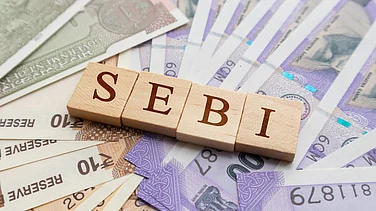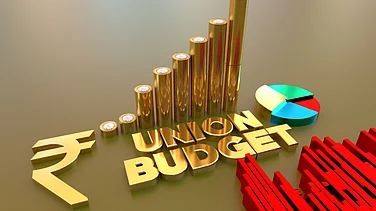The world’s largest economy is burning and its currency is about to turn into ash. The conclusion of the book titled RIP USD 1971-202X is grim and alarming. Author Shanmuganthan N, not strictly an economist by profession, says “this is the end of the world as we know it”.
In an interview with Outlook Business, he talks about the theories applied to arrive at his conclusion, which suggests that the US economy is on the brink of a collapse even greater than that of 2008. Commentators in the US who have reviewed his book refer to the impending crisis as the "Greater Depression."
Much like the previous crisis, this is an entirely government caused crisis, says Shanmuganathan. He describes the current monetary system as fundamentally flawed and predicts that a shift from the paper currency system back to a gold standard is inevitable.
Edited Excerpts:
Could you begin by explaining the ideology that led to the conclusions in your book?
The book is grounded in the Austrian School of Economics, which is far-right economic ideology also known as “Lassiez Faire Economics” or more commonly as “Free Market Capitalism”. Interestingly, what we call "far-right" in India, like the BJP (Bharatiya Janata Party), isn't far-right at all. In fact, BJP's economic stance today is left of center. Perhaps even to the left of what the Congress was during 2004-2014.
The Austrian School emphasises minimal government intervention, restricting government functions to just two areas: the protection of private property (via policing and the military) and the enforcement of contracts (through the court and justice systems). Essentially, in a truly capitalistic society, the federal government's role is limited to these functions. The other requirement of a capitalistic system is the gold standard (sound money) which is the primary focus of the book.
The US operated as a capitalistic society up until 1913, which is when the Federal Reserve was established. Before that, the country functioned under what was known as a classical gold standard. Unlike today, there was no central bank defining what money was—each bank had the freedom to print its own currency as long as it was convertible to gold.
After 1913, the US ceased to be a capitalistic system. Many still mistakenly view it as such, but it longed ceased being one. The shift away from the gold standard marked the end of that era. The changes happened gradually starting with 1933 when ownership of gold was made illegal for US citizens. The final step happened in 1971 when Richard Nixon “temporarily” closed the Gold Window. However, the momentum built up even during the quasi gold standard has allowed the US to endure, but now, it’s teetering on the brink of a major collapse. That’s what I explore in my work.
What convinces you that the shift from the gold standard to a full paper currency system was a huge mistake?
I compared the economic growth during the gold standard era with the period after it was abandoned. It's important to recognise that the term "gold standard" doesn't refer to just one system. Up until 1913, the US operated under the classical gold standard, where there was no central bank.
After 1933, the US moved to a system known as the gold exchange standard. In this system, while there was a central bank (the Federal Reserve), individuals couldn’t directly exchange dollars for gold, but other central banks could. This arrangement still imposed a limit on how much money the US government could print because foreign central banks had the option to convert dollars into gold.
That system lasted until 1971, after which the dollar took on a completely different character. The dollar post-1971 is fundamentally different from the one that existed under the gold exchange standard.
Before 1971, there was a reasonably strong linkage to gold, which acted as a constraint on money printing. The US government couldn't print excessive amounts of money, so it was forced to live within its means. This all changed in 1971, when the gold standard was completely abandoned. Since then, they’ve been printing without any restraint.
For context, to reach the first trillion dollars in national debt, it took the US government almost 200 years—from 1789 to 1982. Now, they add a trillion every 100 days. This is the consequence of removing the gold standard, which essentially allowed for unchecked government growth.
Do you mean to say the government then abandoned the gold standard for its own benefits?
Who benefits from the printing of money? It’s the government, not the society. The growth of government comes at the expense of the private sector and citizens. The gold standard acted as a restraint on government spending, and that’s the most critical aspect to understand.
When the US was on the gold standard, the economic growth was extraordinary. Had the gold standard continued, we can only imagine how far the US could have progressed—perhaps people would have flying cars by now! Maybe people might have to work only three days a week. From a poor agrarian society, the US transformed into the most prosperous nation in the world, and most major innovations, except for the internet, occurred under the gold standard.
In just one generation under the gold standard (1850 to 1913), transportation changed from horse driven carriages to locomotives and then to cars and onto aeroplanes. The US witnessed at least a nominal 4 per cent growth in conjunction with falling prices in that period.
Despite criticisms that gold is a "dead asset," history tells a different story.
In the book, you speak about a bubble that is going to burst soon. Will you explain?
The artificial boom occurs when low interest rates, deliberately set by central banks, encourage excessive borrowing and risk-taking. This inflates asset bubbles across markets, whether in real estate, stocks, or other sectors. The problem is that these artificially low interest rates are not backed by actual savings within an economy and hence the economy is on fragile economic foundations.
When the Federal Reserve eventually hikes interest rates to control price inflation or the inflated asset prices, the bubble bursts. We’ve seen this pattern repeatedly. For example, the 2008 financial crisis was triggered by the Fed keeping interest rates at around 1 per cent for a couple of years, which contributed to the housing bubble. Now, consider the impact of near-zero interest rates since the 2008 crisis. The asset bubbles that have formed are much larger, and when they burst, the consequences would be far more severe. The 2008 crisis might end up looking like the proverbial Sunday school picnic.
But if it is so evident, then should not the government be aware of it and try to mitigate the damage?
Politicians, relying on central banks, perpetuate this cycle because it allows them to avoid immediate accountability. By inflating the currency, governments effectively tax the public without voters recognising it as such. Inflation drives up prices, disproportionately affecting the poor, who struggle with the rising cost of essentials. This causes an invisible wealth transfer from the poor and middle class to governments and wealthier segments of society.
Without central banks, this boom-bust cycle might be mitigated, but since they provide a mechanism for indirect taxation and wealth redistribution, governments are unlikely to abandon them.
The idea of returning to the gold standard or adopting a commodities-backed currency system is largely opposed by central banks because it would significantly reduce their control over monetary policy. Central banks rely on their ability to regulate and inflate currency as needed, something the gold standard, or free banking, would severely limit.
You won't eliminate boom-bust cycles unless we have the restraint of sound money.
Do you conclude that this situation is now unavoidable?
In 1980, the US national debt was under a trillion dollars, while by 2022; it had ballooned to around 33 trillion dollars. Despite this massive increase, the interest payments were higher in 1980 due to interest rates being at 20 per cent. In contrast, interest rates in 2022 were near zero, leading to lower absolute interest outgo.
However, the landscape changed dramatically in the last couple of years. As interest rates have risen from 0 per cent to about 5 per cent, the US now spends approximately 30 per cent of its revenue just on servicing interest costs—without even touching the principal. Projections suggest this could rise to 50 per cent in the next two years, as the current interest rate on the national debt is just about 3 per cent and is set to increase further due to the new issuances as well as refinancing the maturing debt at much higher interest rates.
We should also remember the 200 plus trillion dollars of the unacknowledged debt of the US Government, the bulk of which is future Social Security and Medicare payments owed to the citizens.
The US debt situation is way beyond any meaningful solution and there is no way to avoid a currency crisis at this juncture. The only question is when? I think the asset bubbles bursting would be the start of this. Maybe a few weeks – or a few months. I don’t think it can be prolonged in terms of “years” now.
So, the thesis of your book that is fall of the US dollar is based upon this impending crisis.
The Continental Dollar, issued by the US government from 1777 to 1781, became worthless due to excessive printing. A similar fate awaits the US dollar. As the government prints vast quantities to manage debt and expenses, the dollar's value would plummet.
We are going to have the three asset bubbles – stocks, bonds, and real estate – burst one after the other. While it's hard to say which will collapse first, my guess is that it will be the housing bubble that will burst first. This would inevitably draw mistaken comparison to the 2008 crisis. This is going to be a global currency crisis.
Ironically, the US dollar’s demise is not going to happen because of the asset bubbles bursting, but because of the solution that would be adopted by the US Federal Reserve as a response to the burst.
How much should India be worried at the moment?
The upcoming economic situation is projected to be significantly worse than the 2008 crisis. Unlike 2008, when commodity prices fell, this time, we will see soaring prices for imports like gold and oil. In contrast, India's key exports, such as software and pharmaceuticals to the US, are expected to collapse. The US is set to enter a prolonged inflationary depression, and if not managed properly, the impact on India will be much worse than 1991.
The unfortunate part is that this is a White Swan, which is a very foreseeable economic crisis. India ought to have started preparing in terms of deregulation and running balanced budgets long back. But starting today is better than tomorrow.



























